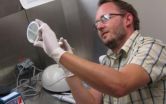(Press-News.org) It all started with a crab apple tree.
Two years ago, a 71-year-old Indiana man impaled his hand on a branch after cutting down a dead tree. The wound caused an infection that led scientists to discover a new bacterium and solve a mystery about how bacteria came to live inside insects.
On Oct. 15, 2010, Thomas Fritz, a retired inventor, engineer and volunteer firefighter, cut down a dead, 10-foot-tall crab apple tree outside his home near Evansville, Ind.
As he dragged away the debris, he got tangled in it and fell. A small branch impaled his right hand in the fleshy web between the thumb and index finger.
A former emergency medical technician, Fritz dressed the wound, which became swollen. Then he waited for a scheduled visit with his doctor a few days later. By then, a cyst formed at the wound site. The doctor put Fritz on an antibiotic after sending a sample of the cyst to a lab.
The pain and swelling persisted and the wound became abscessed.
About five weeks after the accident, an orthopedic surgeon removed several pieces of bark from the wound, which finally healed without further incident.
Only later did Fritz find out that his infected wound contained a previously unknown bacterium that scientists say could be used to block disease transmission by insects and prevent crop damage.
Scientists call the new strain human Sodalis or HS; it's related to Sodalis, a genus of bacteria that lives symbiotically inside insects' guts.
The journal PLOS Genetics published a paper detailing the discovery today.
"Symbiotic interactions between microorganisms and insects are common, and biologists suspect that they're an important driver of biological diversification," says Matt Kane, program director in the National Science Foundation's Division of Environmental Biology, which funded the research.
"But how such symbioses came to be is often a mystery," Kane says. "This particular story has a happy ending, but also an interesting one, because researchers used it to gain insight into how insects and microbes can form symbiotic partnerships in the first place."
As in the case of the crab apple tree, "there are bacteria in the environment that form symbiotic relationships with insects," says University of Utah biologist Kelly Oakeson, the study's lead co-author. "This is the first time such a bacterium has been found and studied."
Identifying a New Strain of Bacteria
The lab that first received the sample from Fritz's infected wound couldn't identify the bacterium once it was isolated. So the organism was shipped to ARUP Laboratories, a national pathology reference library operated by the University of Utah.
An automated analysis at ARUP found that the bacterium from Fritz was E. coli, but scientists doubted the results.
"We had close matches for it, but none were validly described species," says Mark Fisher of the ARUP Institute for Clinical and Experimental Pathology and a co-author of the paper. "It caught my eye because I knew Colin Dale worked on Sodalis."
Dale is the researcher who discovered and named Sodalis in 1999. He is a biologist at the University of Utah and is the study's senior author.
He says that genetic sequencing showed that the HS bacterium is related to bacteria that live symbiotically in 17 insect species, including tsetse flies, weevils, bird lice and stinkbugs, and is most closely related to bacteria in the chestnut weevil and a stinkbug species.
The study compared HS with genomes of the strain Sodalis glossinidius that lives in tsetse flies and another Sodalis-like bacterium that lives in grain weevils.
Compared with HS, the other two bacterial species have lost or deactivated about half their genes.
A Missing Link
According to Dale, the findings provide "a missing link in our understanding of how beneficial insect-bacteria relationships originate.
"They show that these relationships arise independently in each insect. The insect picks up a pathogen that is widespread in the environment and then domesticates it. This happens independently in each insect."
A competing theory is that parasitic wasps and mites spread symbiotic bacteria from one insect to another.
Dale says that theory cannot explain why such similar types of Sodalis bacteria are found in insects that differ widely in location and diet, including insects that feed either on plants or animals.
The new results support the theory that insects are infected by pathogenic bacteria from plants or animals in their environment, and that the bacteria evolve to become less virulent and to provide benefits to the insect.
Then, instead of spreading from one insect to another, the bacteria spread from mother insects to their offspring.
Taming Invading Bacteria
Various bacteria live symbiotically in blood or fat cells or in special structures attached to the guts of as many as 10 percent of all insects.
The bacteria gain shelter and nutrition from their insect hosts, and they produce nutrients--B vitamins and amino acids--to help feed the insects.
Sometimes they also produce toxins to kill invaders, such as fungi or the eggs laid in an insect by a parasitic wasp.
Sodalis is only one of several types of bacteria that live in insects.
Symbiotic bacteria are known for having the smallest genetic blueprints, or genomes, of any cellular organism because as they evolve inside an insect, they lose genes that would be needed for survival outside the insect.
But when biologists sequenced the new bacterium's genome, they found that HS has a relatively large genetic blueprint and is closely related to Sodalis-like bacteria that have smaller genomes and live in many species of insects, implying that Sodalis-like bacteria all descended from a bacterium like HS.
A Way to Block Some Insect-Spread Diseases?
The researchers believe the discovery could have important implications. They say it may be possible to genetically alter the new bacterium to block disease transmission by insects like tsetse flies and prevent crop damage by insect-borne viruses.
"If we can genetically modify a bacterium that could be put back into insects, it could be used as a way to combat diseases transmitted by those insects," says Adam Clayton, a University of Utah biologist and lead author of the paper unveiling the new bacterium and its genome.
Tsetse flies and aphids both carry symbiotic Sodalis bacteria related to strain HS. Sodalis doesn't grow well outside insects, but HS grows well in the lab.
So it may be possible to insert genes in HS, and then place the bacteria in tsetse flies to kill the protozoan parasites that live in the flies and cause sleeping sickness in people and domestic animals in Africa.
Aphids transmit many plant viruses that attack soybeans, alfalfa, beets, beans and peanuts.
Replacing their normal symbiotic bacteria with a genetically engineered strain of HS could interfere with disease transmission.
The researchers speculate that in addition to the HS bacterium, there are likely many other undiscovered bacteria in the environment that could form symbiotic relationships with insects.
"We have identified very few of the bacteria that exist in nature," says Dale, "and new species and strains like HS are often only discovered when they infect humans."
INFORMATION:
Additional co-authors of the paper are Maria Gutin, Arthur Pontes, Diane Dunn, Andrew von Niederhausern and Robert Weiss, all of the University of Utah.
The National Institutes of Health also funded the research.
Microbial 'missing link' discovered after man impales hand on tree branch
Scientists uncover how insects domesticate bacteria
2012-11-26
ELSE PRESS RELEASES FROM THIS DATE:
Water resources management and policy in a changing world: Where do we go from here?
2012-11-26
Visualize a dusty place where stream beds are sand and lakes are flats of dried mud. Are we on Mars? In fact, we're on arid parts of Earth, a planet where water covers some 70 percent of the surface.
How long will water be readily available to nourish life here?
Scientists funded by the National Science Foundation's (NSF) Dynamics of Coupled Natural and Human Systems (CNH) program are finding new answers.
NSF-supported CNH researchers will address water resources management and policy in a changing world at the fall meeting of the American Geophysical Union (AGU), ...
Burning more calories is easier when working out with someone you perceive as better
2012-11-26
MANHATTAN, Kan. -- The key to motivation in physical activity may be feeling inadequate. One Kansas State University researcher found that those who exercised with a teammate whom they perceived to be better increased their workout time and intensity by as much as 200 percent.
Brandon Irwin, assistant professor of kinesiology, was the principle investigator in a study that tested whether individuals engage in more intense physical activity when alone, with a virtual partner or competing against a teammate.
"People like to exercise with others and make it a social activity," ...
Funneling the sun's energy
2012-11-26
CAMBRIDGE, Mass. — The quest to harness a broader spectrum of sunlight's energy to produce electricity has taken a radically new turn, with the proposal of a "solar energy funnel" that takes advantage of materials under elastic strain.
"We're trying to use elastic strains to produce unprecedented properties," says Ju Li, an MIT professor and corresponding author of a paper describing the new solar-funnel concept that was published this week in the journal Nature Photonics.
In this case, the "funnel" is a metaphor: Electrons and their counterparts, holes — which are ...
Stopping flies before they mature
2012-11-26
An insect growth regulator is one of the latest technologies U.S. Department of Agriculture (USDA) scientists are adding to their arsenal to help fight house flies that spread bacteria to food.
Agricultural Research Service (ARS) scientists at the agency's Center for Medical, Agricultural, and Veterinary Entomology in Gainesville, Fla., are using an insect growth regulator called pyriproxyfen to kill house flies that spread bacteria that can cause diarrhea and other illnesses. When pyriproxyfen is applied to larval breeding sites such as manure, it mimics a hormone in ...
Scanning innovation can improve personalized medicine
2012-11-26
New combinations of medical imaging technologies hold promise for improved early disease screening, cancer staging, therapeutic assessment, and other aspects of personalized medicine, according to Ge Wang, director of Virginia Tech's Center for Biomedical Imaging, in a recent paper that appeared in the refereed journal PLOS ONE.
The integration of multiple major tomographic scanners into a single framework "is a new way of thinking in the biomedical imaging world" and is evolving into a "grand fusion" of many imaging modalities known as "omni-tomography," explained Wang, ...
Model sheds light on the chemistry that sparked the origin of life
2012-11-26
Durham, NC – The question of how life began on a molecular level has been a longstanding problem in science. However, recent mathematical research sheds light on a possible mechanism by which life may have gotten a foothold in the chemical soup that existed on the early Earth.
Researchers have proposed several competing theories for how life on Earth could have gotten its start, even before the first genes or living cells came to be. Despite differences between various proposed scenarios, one theme they all have in common is a network of molecules that have the ability ...
Deciphering bacterial doomsday decisions
2012-11-26
Like a homeowner prepping for a hurricane, the bacterium Bacillus subtilis uses a long checklist to prepare for survival in hard times. In a new study, scientists at Rice University and the University of Houston uncovered an elaborate mechanism that allows B. subtilis to begin preparing for survival, even as it delays the ultimate decision of whether to "hunker down" and withdraw into a hardened spore.
The new study by computational biologists at Rice and experimental biologists at the University of Houston is available online in the Proceedings of the National Academy ...
Continuing Thanksgiving eruptions on the sun
2012-11-26
On Nov. 23, 2012, at 8:54 a.m. EST, the sun erupted with an Earth-directed coronal mass ejection or CME. Experimental NASA research models, based on observations from the Solar Terrestrial Relations Observatory (STEREO) and the ESA/NASA mission the Solar and Heliospheric Observatory, show that the Nov. 23 CME left the sun at speeds of 375 miles per second, which is a slow to average speed for CMEs. This is the third Earth-directed CME since Nov. 20.
Not to be confused with a solar flare, a CME is a solar phenomenon that can send solar particles into space and can reach ...
Personalities influence workforce planning
2012-11-26
Montreal, November 26, 2012 – What if factory foremen treated their workers less like the machines they operate, and more like people, with personality strengths and differences? Surely the workers would benefit, but might the employers also see positive results in the workplace, as well as being able to cut costs?
That's what Concordia researcher Mohammed Othman set out to prove in his paper "Integrating workers' differences into workforce planning," recently published in the journal Computers & Industrial Engineering.
Currently, explained Othman, two types of researchers ...
Bothered by negative, unwanted thoughts? Just throw them away
2012-11-26
COLUMBUS, Ohio -- If you want to get rid of unwanted, negative thoughts, try just ripping them up and tossing them in the trash.
In a new study, researchers found that when people wrote down their thoughts on a piece of paper and then threw the paper away, they mentally discarded the thoughts as well.
On the other hand, people were more likely to use their thoughts when making judgments if they first wrote them down on a piece of paper and tucked the paper in a pocket to protect it.
"However you tag your thoughts -- as trash or as worthy of protection -- seems to ...
LAST 30 PRESS RELEASES:
Numbers in our sights affect how we perceive space
SIMJ announces global collaborative book project in commemoration of its 75th anniversary
Air pollution exposure and birth weight
Obstructive sleep apnea risk and mental health conditions among older adults
How talking slows eye movements behind the wheel
The Ceramic Society of Japan’s Oxoate Ceramics Research Association launches new international book project
Heart-brain connection: international study reveals the role of the vagus nerve in keeping the heart young
Researchers identify Rb1 as a predictive biomarker for a new therapeutic strategy in some breast cancers
Survey reveals ethical gaps slowing AI adoption in pediatric surgery
Stimulant ADHD medications work differently than thought
AI overestimates how smart people are, according to HSE economists
HSE researchers create genome-wide map of quadruplexes
Scientists boost cell "powerhouses" to burn more calories
Automatic label checking: The missing step in making reliable medical AI
Low daily alcohol intake linked to 50% heightened mouth cancer risk in India
American Meteorological Society announces Rick Spinrad as 2026 President-Elect
Biomass-based carbon capture spotlighted in newly released global climate webinar recording
Illuminating invisible nano pollutants: advanced bioimaging tracks the full journey of emerging nanoscale contaminants in living systems
How does age affect recovery from spinal cord injury?
Novel AI tool offers prognosis for patients with head and neck cancer
Fathers’ microplastic exposure tied to their children’s metabolic problems
Research validates laboratory model for studying high-grade serous ovarian cancer
SIR 2026 delivers transformative breakthroughs in minimally invasive medicine to improve patient care
Stem Cell Reports most downloaded papers of 2025 highlight the breadth and impact of stem cell research
Oxford-led study estimates NHS spends around 3% of its primary and secondary care budget on the health impacts of heat and cold in England
A researcher’s long quest leads to a smart composite breakthrough
Urban wild bees act as “microbial sensors” of city health.
New study finds where you live affects recovery after a hip fracture
Forecasting the impact of fully automated vehicle adoption on US road traffic injuries
Alcohol-related hospitalizations from 2016 to 2022
[Press-News.org] Microbial 'missing link' discovered after man impales hand on tree branchScientists uncover how insects domesticate bacteria



